Labeling the New Kids
Available as Press Release (PRWeb) in a longer version here.
Today's children have been variously described of late as Indigos (because of the supposed color of their auras), Star Kids (because of their purported origination from other worlds), Crystals (because some say they are highly developed), and so forth. None of these claims hold up to the degree that they are made when subjected to objective research, whether via scientific observation or by the study of mystical/esoteric traditions or through a summary of visionary revelations.
Professionals in the field of child development and education, parents, even the kids themselves, are having problems with the idea that certain character traits are the sole province of special youngsters when, in fact, the vast majority of to-day's children match those same traits – without evidencing anything like a purple aura, or being a hybrid from another planet, or possessing "god-like" wisdom. Being supersensitive, confident, highly intelligent, unusually creative, nonconformist, extraordinarily psychic and spiritually aware, impatient, empathic, able to heal or aid others in significant ways, abstracting at young ages, spatial learners, great at problem-solving yet difficult to parent or educate – these characteristics and many more are typical to the broad span of youth worldwide and has been since around 1982.
The labeling fad so popular now began in the late seventies when several psychics started talking about the numbers of children they saw who had purple auras. They named them "Indigos." This was followed by the success of Lee Carroll's and Jan Tober's book, The Indigo Children: The New Kids Have Arrived. Their success spawned a cottage-industry of books, tapes, toys, clothes, and gadgets, which ballooned out-of-portion by media hype used to promote the idea of "world indigo day" and "indigo revolution" - so indigo films would sell.
The psychically gifted people who originally noticed something unusual about children claimed that what they were seeing was widespread. What was wide-spread were the traits and characteristics they saw, not the aura color of indigo. The result of their claims is an incomplete model that confuses even the most sincere, and boxes kids into the exclusivity of specialness.Our kids don't need this. What they need are guidance, discipline, lots of love, and parents wise enough to ask questions before assuming anything.
###
P. M. H. Atwater, L.H.D. is one of the original researchers in the field of near-death studies, having begun her work in 1978. To date, she has published seven books on her findings and countless papers and articles. Throughout her work, she noticed a similarity between children who were near-death experiencers and children who were simply born that way – with the same differences and enhancements that near-death kids displayed after their episode. She wrote Beyond the Indigo Children: The New Children and the Coming of the Fifth World to pass on what she discovered. The addendum to the book is located on http://www.pmhatwater.com.


3 Comments:
Indigo Children exist. For years I have sought to understand who I am. Now things make much more sense. I am an Indigo Child and I can see many things many others cannot. I fit the description VERY strongly and I cannot relate to most people. Just people who are advanced like me. Its not a superiority complex. Its evolution.
Indigo Children exist. For years I have sought to understand who I am. Now things make much more sense. I am an Indigo Child and I can see many things many others cannot. I fit the description VERY strongly and I cannot relate to most people. Just people who are advanced like me. Its not a superiority complex. Its evolution.
Of course you do. So do I – to a tee. So does hundreds of thousands of millions of people. This is where our human race is moving. We are evolving. This is us. But to call us “indigos” (using that label) is limiting and does not even begin to cover, at least in my opinion, what is really going on. Why limit yourself? If you want to call yourself an indigo, fine. But I know you are much more than that, and I think you do too. That is my point, and always has been. These labels, all of them, miss the mark. When you look at the broader evolutionary changes, as I do, what is happening now to the human race is very, very exciting. Blessings, PMH
Post a Comment
<< Home